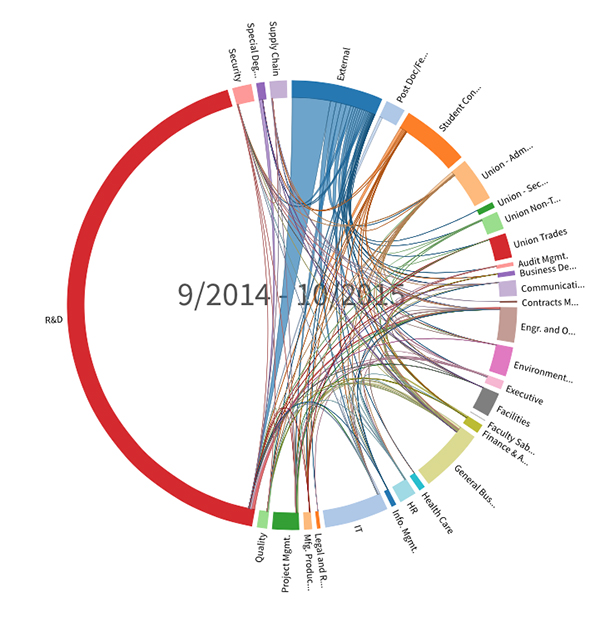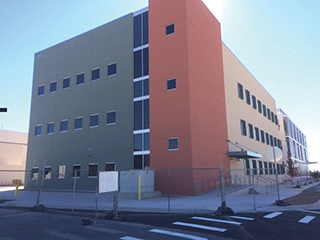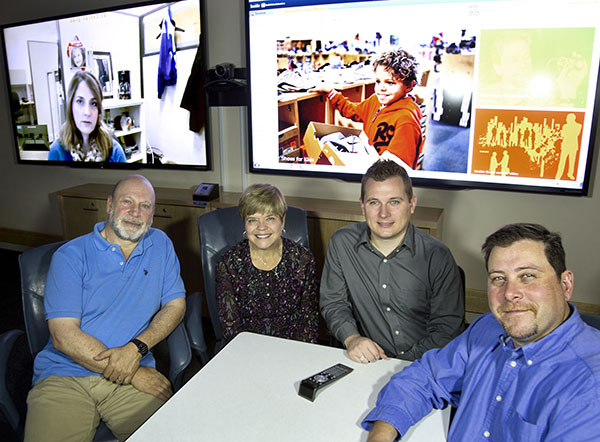Integrating data for better decision-making

This ASK visualization shows movements between and among groups of staff at Sandia over various time periods.
Analytics for Sandia Knowledge (ASK), a new tool primarily for managers, allows users to find data from multiple Sandia sources and integrates and presents the results in dashboards, visualizations, and interactive capabilities. The initial set of capabilities includes integrated HR and other data for detailed analyses, tools for understanding organization and personnel expertise, staff transitions, workforce education, employee retention, and organizational safety. Future capabilities will integrate additional data sources and methods to interact with it. (9500) IMS, LF
Center 4800 restructured all its major planning documents to provide a foundation for a corporate investment strategy that matches division priorities to the appropriate funding sources. This effort started with the Long-Range Development Plan and Long-Range Development Framework, along with the Technical Area Plans, which provide the structure for the short- and long-term planning within the context of the entire Laboratory. In turn, Facilities and Infrastructure Plans were developed by each division to articulate their needs, which will then inform the Five-Year and Ten-Year Site Plans. IMS, LF

Building 705 in Tech Area I.
Building 705 IGPP (institutional general plant projects) construction was completed in October 2015 within budget and with zero safety incidents. It is the fourth of five institutional assets constructed with IMS funding, in accordance with an LLT agreement in FY12. The building provides offices and light laboratory space to benefit multiple mission elements, including ongoing science and technology activities and major program initiatives. The three-story, 26,000-square-foot structure is located in Tech Area 1. (2900, 4200, 4800, 9300, 10200) IMS, LF
The Red Remote tool implementation was expanded from the SRN environment to include users on the SCN. The tool allows a technician to troubleshoot and provide support. This reduces support of a typical request to install software from several hours to about 10 minutes. As a result, customers are now able to get a solution with a single call and return quickly to making the mission successful. (9300) IMS, LF
Public Key Infrastructure (PKI) Two-Factor Authentication is now operational for the Sandia Partnering Network. To date, more than 700 users are able to use PKI credentials for system access, with an anticipated additional 600 users by February 2016. This milestone marks the largest implementation and achievement of a key NNSA project related to smart card usage. IMS, LF
Enterprise BI (9548) and Nuclear Security Enterprise & Cost Analysis (0157) partnered to build the Cost Data Continuum (CDC) tool based on Excel pivot table technologies that are readily usable by analysts. This tool enables analysts to recreate programmatic cost datasets going back to 1994 to aid current estimators responsible for planning Sandia’s future programs. Initiatives that formerly required months and hundreds of hours to complete now require as little as a day while ensuring a repeatable, traceable, valid, and credible process. (0150, 9500) IMS, LF
New videoconferencing capabilities

Jeff Jortner, Diane Gomes, Joshua Crawford, and Corbin Stewart (all 8944) hold a videoconference with Lanette Radliff (8944-1). They were all part of the team that spearheaded the new video capabilities.
The Videoconferencing and Collaborative Technologies team engineered and deployed a new videoconferencing infrastructure providing Virtual Meeting Room (VMR) capabilities for unclassified videoconference meetings. The new system will allow location-independent videoconferencing by assigning a VMR number that uniquely identifies a meeting. Using that number, meeting participants can join from wherever they are, even at the airport or off-site. Compatible technologies include traditional videoconferencing room systems, a Lync Room System, Skype for Business on a desktop, and even an iPhone or iPad. IMS, LF